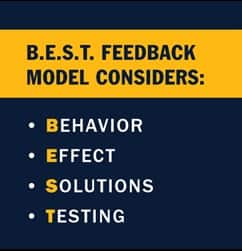How to Give Feedback: What's Equity Got to Do with It?

Feedback is a necessary part of personal and professional growth. We need feedback to understand how we are performing in our roles and where we are still developing. Understanding what we are doing well and where we may have opportunities to improve enables us to make informed decisions about our work.
With this insight, we are empowered to make the necessary changes to critical behaviors and positively impact our performance, giving us agency over our careers and, ultimately, our future.
Without feedback, careers can be stalled, derailed or prematurely ended, impacting our promotional prospects, financial well-being, self-esteem and livelihood.
The Intersection of Feedback and Equity
Gallup defines equity as, “fair treatment, access and advancement for each person in an organization.” How do you think you’re doing when it comes to providing equitable feedback?
Equitable feedback is not about giving each employee the same quantity of feedback; it’s about giving all employees the same quality feedback. It's about giving each individual the feedback they need to improve, maintain or celebrate their performance.

What are 3 Qualities Equitable Feedback Should Have?
Here are a few tips to make your feedback more equitable:
1. Make it Accessible
Making feedback more accessible simply means that feedback can be easily obtained. A Harvard Business School article shared that many employees cite managers providing critical feedback as important to their career, but only 5% believe managers provide it. Employees want to access the feedback you have for them, but it appears as though the feedback may not reach everyone.
Do you make feedback accessible, or do those who need feedback from you have to work to get it? Do you only give feedback to some and not others? Exploring your personal biases and how they influence who you give feedback to, who you don’t and why is critical to making feedback more accessible.
We all need feedback to grow, but studies show that professionals of color receive less constructive feedback than their white colleagues, according to Harvard Business Review. This feedback gap can have a negative impact on the upward mobility of employees of color in the workplace.
If you want to address equity within your workplace, start making feedback accessible.
So, How Can You Make Feedback More Accessible?

Providing feedback only at the annual performance review is much too late and too infrequent. Employees should be able to receive feedback year-round so they are able to make real-time adjustments to their performance well before their review.
To make feedback accessible, designate specific times in which you provide feedback. Your 1:1 meetings are great times to provide feedback on performance in real time. You can also host monthly or quarterly reviews so there are several points in which you can discuss strengths and opportunities about their performance.
To make feedback more accessible, I’ve incorporated what I call “Feedback Fridays” into my monthly business plans. Feedback Fridays are 30-minute monthly meetings with each employee that are designed to simply reflect on feedback. This designated day forces me to think about the employee’s performance over the last month and provide positive or constructive feedback, if necessary.
This signals to the employee that they will have access to the feedback (that may not have been provided previously) and gives us a space where both the manager and employee can build the mental and emotional readiness one may need to prepare for the discussions. While current 1:1s are great places to provide feedback, this approach ensures that the meeting is focused on feedback and can act as a catch-all touch point if you weren’t able to discuss feedback during your typical 1:1 meeting.
Building feedback points into your normal workflow is a healthy way to build a feedback-rich culture and provides multiple ways in which they might access the feedback needed to be successful. The key is to provide the feedback, not withhold it, and do so in real time so they have the opportunity to apply it.
2. Make it Specific
Women have made significant progress when it comes to advancing into leadership, yet they still remain underrepresented in senior leadership roles in the United States. Only 9% of CEOs in the top 100 companies in the Standard & Poor’s stock market index are women, according to a Harvard Law School Forum on Corporate Governance. That is an equity gap.
So what’s feedback got to do with it? Did you know that women are more likely to receive vague feedback compared to men?
In the Harvard Business Review (HBR) article, “Vague Feedback Is Holding Women Back,” researchers highlight that women are systematically less likely to receive specific feedback, both for praise and constructive feedback. This leaves many women left to figure out what they need to do to improve and move up the career ladder. According to the Harvard Business Review article, “vague feedback is correlated with lower performance review ratings for women ... In other words, vague feedback can specifically hold women back.”
Black women are nine times more likely to receive non-actionable feedback in the workplace, according to Forbes. Latina women and Black men were also likely to get vague feedback, Forbes reported, while Asian men and White men are more likely to receive actionable feedback — feedback that is specific enough to learn from and apply to their performance.

So what does equity have to do with feedback? In addition to the lower performance ratings, this equity feedback gap can impact women’s upward mobility and potential earnings in the workplace.
That’s why its important to ensure that all feedback you deliver is specific. Specific feedback gives the receiver a clear picture of which behavior should be repeated, adjusted or abandoned and how it’s tied to performance outcomes. Providing specific feedback increases the likelihood of finding solutions that get at the root of the feedback allowing real time improvements.
What is the Best Feedback Model?
To make feedback more specific and actionable, I created a feedback model called B.E.S.T.: Behavior, Effect, Solutions and Testing.
- When giving feedback it’s important that you take the time to isolate the behavior you want to address. Try to keep it to one or two so that the individual is not overwhelmed by having too many things to focus on. Tie the behavior to an event or situation so that there is context as to where this behavior occurred.
- Next, you want discuss the effect the behavior had on the outcomes, performance, customers, team etc. This helps the receiver understand why this is a behavior that needs to either continue because the outcome was positive, or why it is a behavior that might need to be improved.
- Once you’ve had a chance to share your perspective, give the employee the opportunity to share their perspective and take the lead on potential solutions and steps that might be necessary. This is a great way to ensure that the feedback was clear and that the actions taken are aligned to the root cause.
- Last, you want to discuss where they might test out that new behavior so that you can create space for them to try out their ideas and see if it has the outcome that you both hoped. This is a great way to ensure all parties are clear about what happened and aligned on what could be done to maintain or improve performance.

3. Make it Measurable
Making your feedback measurable is a great way to ensure your feedback is equitable. Measurable feedback means you have quantifiable measures to evaluate someone’s performance on something. Without a measurement of where you are and how far you have to go, feedback can leave the employee feeling unmotivated to even try, causing continued gaps in performance.
In addition, feedback that is not based in fact or measurement can run the risk of falling victim to unconscious bias. The Unconscious Bias Project defines bias as, “prejudice in favor of or against one thing, person or group compared with another, usually in a way considered to be unfair.”
This can show up in a variety of ways, especially when we are evaluating someone’s performance. Without measurement, stereotypes or assumptions can seep into our evaluative process and impede our ability to give equitable feedback.
Without a measurement of success, employees may not feel as though they have the power to move the meter on your feedback. The point here: If you can measure it, you can move it.
Everyone deserves feedback that can be objectively measured. Holding yourself accountable by leveraging measurements in your feedback discussion could reduce the instance of unconscious bias showing up in your feedback conversation.
Using Data in Your Feedback
To make your feedback more measurable, use data as a key part of your feedback conversation so that the feedback is based on facts versus opinion. This helps keep the feedback objective versus subjective, which is usually based on personal perspectives or preferences of the individual giving feedback.
Spend time discussing performance goals and defining what success looks like and what an employee needs in order to reach that goal. This can be a behavior or a metric. This ensures that there is a clear picture of what benchmarks they are striving for and positions you to give feedback and support that is specific to what they need.
Provide feedback in comparison to the performance goals that you set with the individual. This allows them to clearly see how the feedback benefits them, which increases the motivation to apply the feedback immediately. As long as the measurement is clear and consistent across the team, you put yourself in a position to deliver more equitable feedback.
So, What Do I Do Next?
Feedback is a critical part of our development, but it’s important to understand that all feedback is not created equal. Equitable feedback is about giving quality feedback to everyone so that they have the agency to grow, develop and thrive in their roles.
Equitable feedback is quality feedback that is specific enough for the recipient to understand which behavior needs celebrating, which behavior needs improvement, and a clear picture of what success looks or feels like when the feedback is implemented.
There’s a lot to unpack in the feedback experience, but these three tips will ensure that you are building equitable and feedback rich cultures within your organization.
Online. On campus. Choose your program from 200+ SNHU degrees that can take you where you want to go.
Dr. Shanita Williams is a TEDx speaker, LinkedIn Learning instructor, author and the founder and CEO of the The Feedback Mentality Group. She currently serves as a vice president of People Experience and Inclusion in higher education. In her role she collaborates with various stakeholders to co-create people centric policies, programs and practices that drive retention and foster a sense of belonging.
For tips on receiving feedback, read "Personal Growth and Development: Drop the Sponge Mentality" and "How to Handle Criticism: Strainer Mentality Calculator," both written by Williams.
Explore more content like this article

How to Reinvent Yourself

Best Careers for Creative People

Students, Alums Strengthen Skills Through Black History Month Projects
About Southern New Hampshire University

SNHU is a nonprofit, accredited university with a mission to make high-quality education more accessible and affordable for everyone.
Founded in 1932, and online since 1995, we’ve helped countless students reach their goals with flexible, career-focused programs. Our 300-acre campus in Manchester, NH is home to over 3,000 students, and we serve over 135,000 students online. Visit our about SNHU page to learn more about our mission, accreditations, leadership team, national recognitions and awards.

